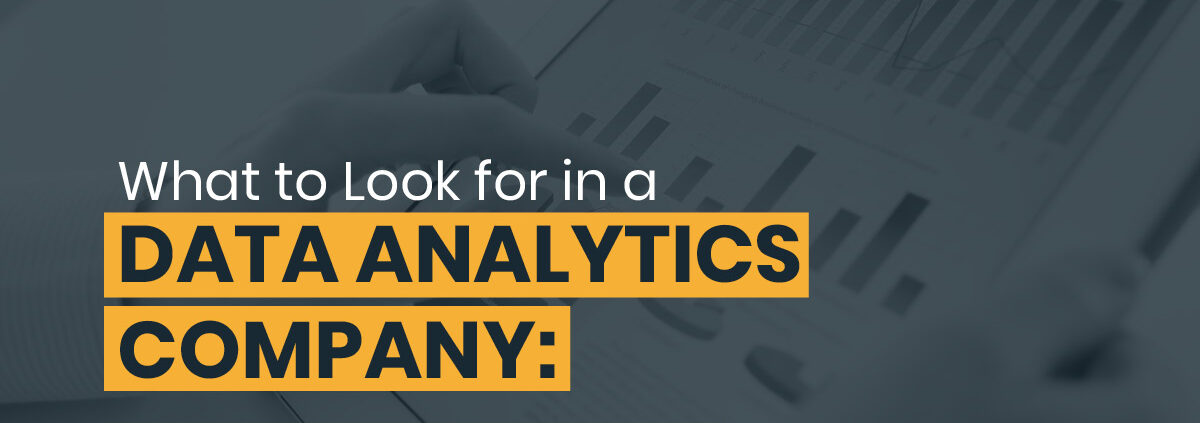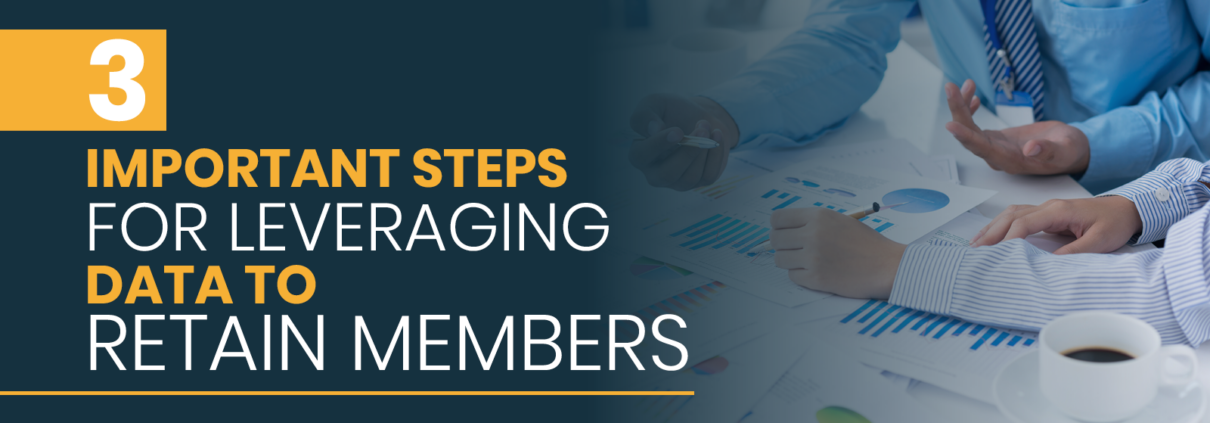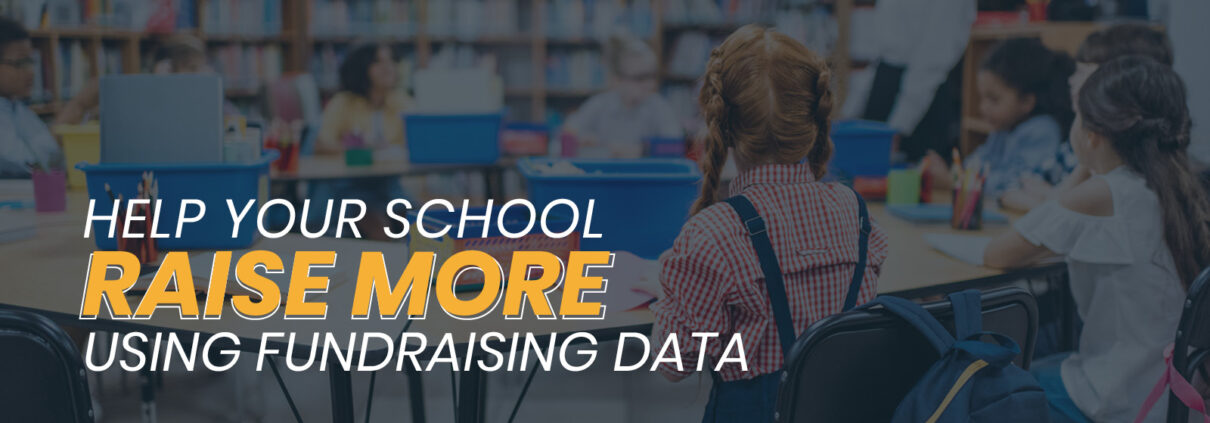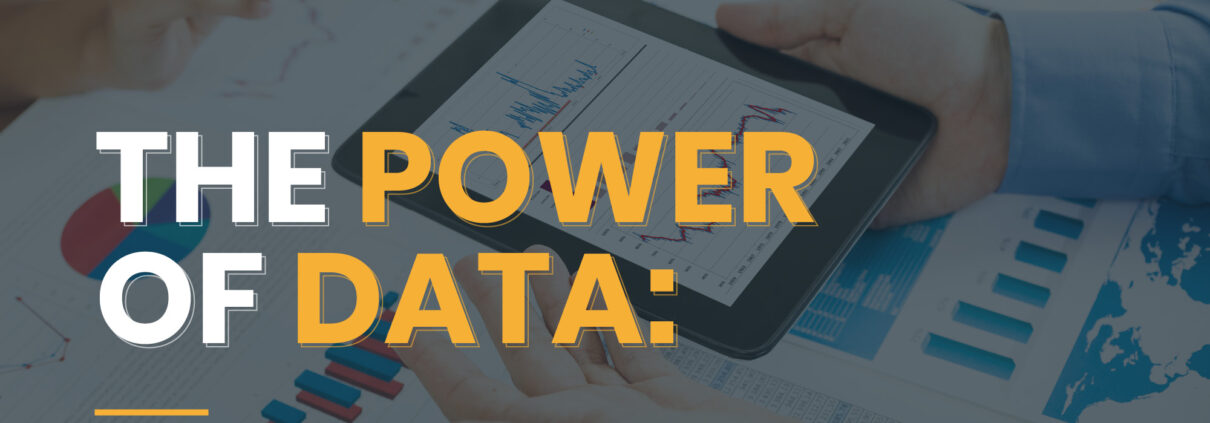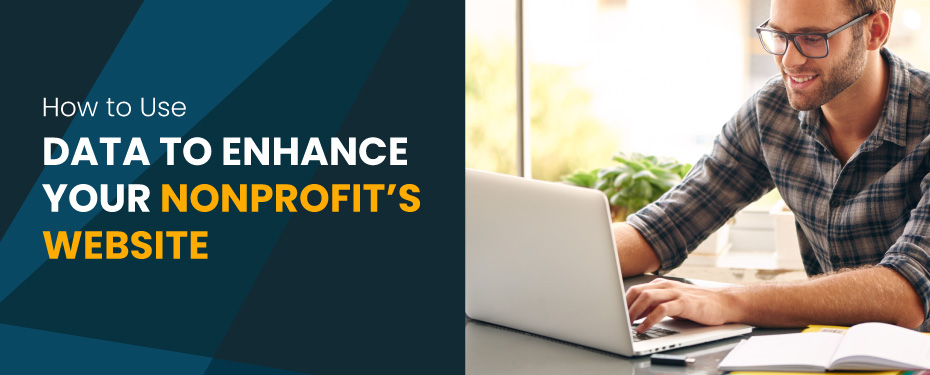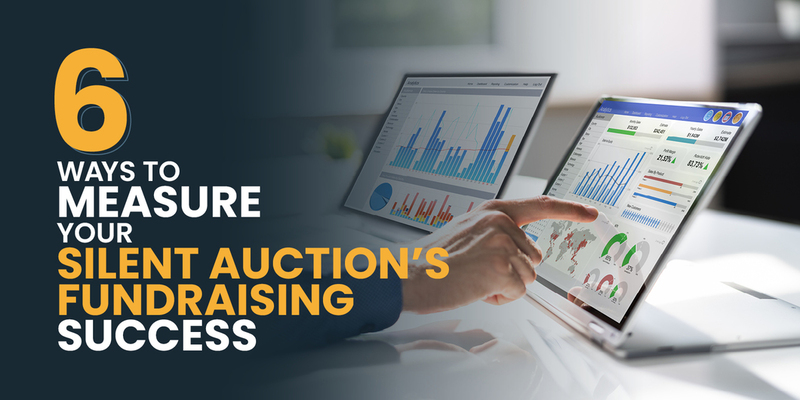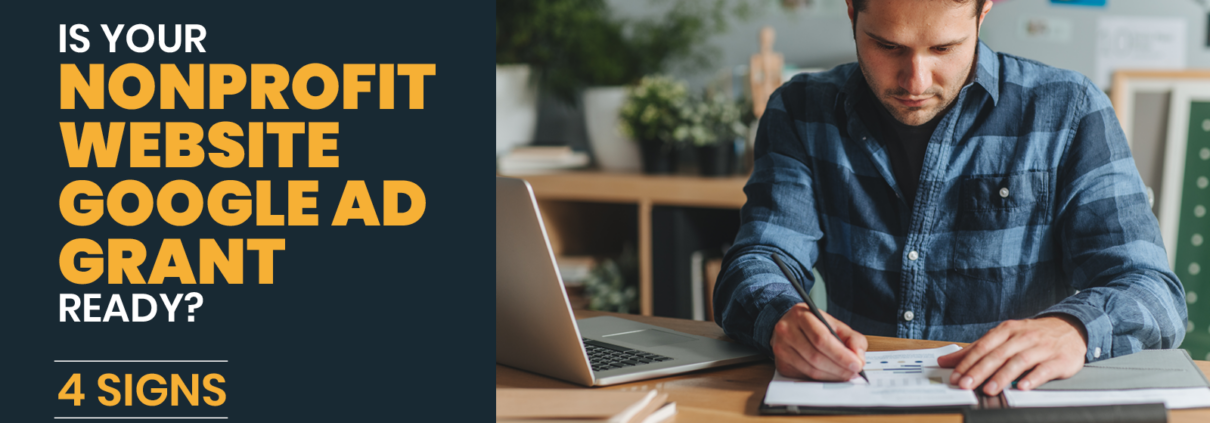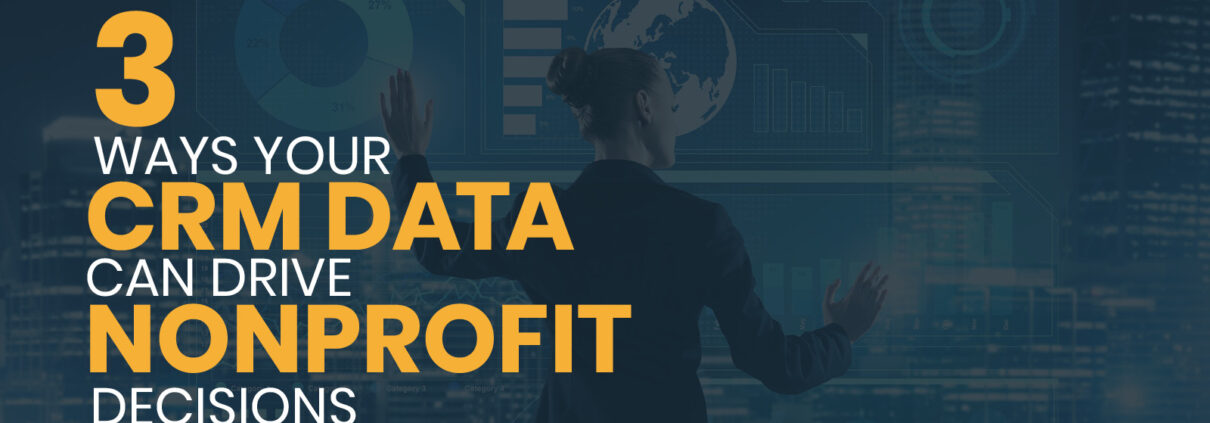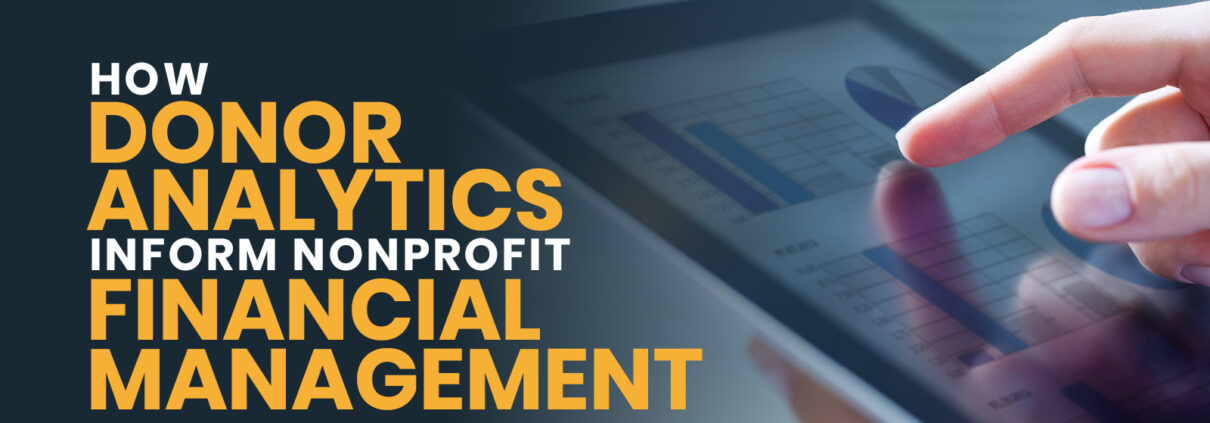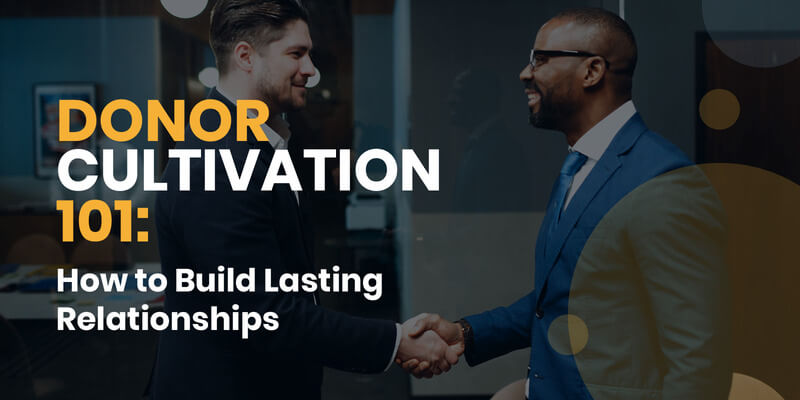Your nonprofit works day in and day out to bring its mission to life. A big part of that is inspiring supporters to donate, attend events, and volunteer for your cause. Although, it doesn’t stop there. From there, you have to steward them and inspire them to stick around for the long term. As a fundraiser, you need to know the donor cultivation cycle inside and out, including everything from locating prospects to inspiring them to continue giving.
At NPOInfo, we understand the importance of establishing relationships and then effectively leveraging donor data to fuel those connections. We know it takes a lot of patience and persistence. For new and seasoned professionals alike, cultivating donors can be challenging. After all, every donor is different!
Our goal with this guide is to demystify the process, so you can build genuine relationships that last. To help, here’s what we’ll cover:
Your prospects and current supporters deserve a positive experience with your organization. Taking steps to establish and steward lasting relationships will go a long way in building a sustainable future for your nonprofit. Let’s dive in.

Donor Cultivation FAQ
Before diving into the nitty-gritty details of the donor cultivation cycle, let’s explore the fundamentals of what cultivation is and why it’s vital to your everyday work. That way, you’ll have the foundational knowledge you need to craft a comprehensive plan.
What Is Donor Cultivation?
Donor cultivation is the process of establishing and strengthening relationships with prospective and current donors over time. The term describes how you identify potential donors, inspire them to give, and steward meaningful relationships with them.
Effective cultivation involves a range of activities, including personalized communication, effective donor recognition, engaging events, and volunteerism. Every stage of the cycle is fueled by insightful data your nonprofit collects, such as donors’ wealth capacities, giving histories, and contact information.
The ultimate goal of donor cultivation is to create a sustainable base of loyal donors who support the organization’s overall mission and goals.
What Are The Goals of Donor Cultivation?
While each nonprofit pursues a different mission, every organization’s reason for cultivating donors remains the same: they want to establish and deepen relationships with those who believe in their cause.
Let’s break down that overarching objective into a few key goals:
- Engage donors: The cultivation process helps create engagement opportunities that encourage interaction with your organization to learn more about your mission, programs, and impact.
- Build trust: Your donor cultivation efforts will build rapport with donors when you demonstrate your organization’s commitment to transparency, accountability, and responsible stewardship of donations.
- Retain donors: Effective cultivation means you can retain donors and inspire them to stay engaged in your activities. The cycle involves maintaining regular communication and recognizing their contributions.
- Boost donor lifetime value: As fundraisers, we all know that donor attrition can be costly. Instead of letting new donors churn, following the donor cultivation cycle religiously will allow you to inspire donors to stick around. By convincing them to give again and give large gifts over time, you’ll increase their lifetime value.
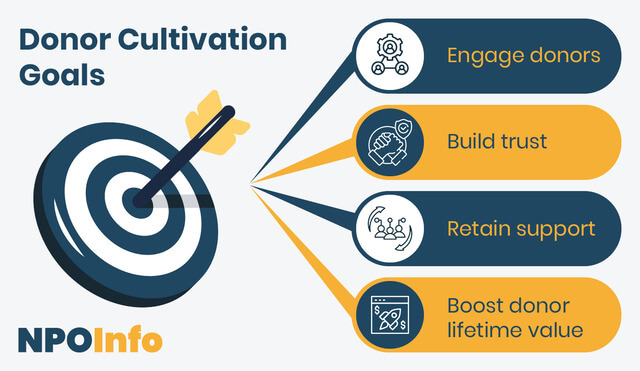
Overall, thoughtful donor cultivation means you can establish a reliable foundation of support.
How Long Does The Donor Cultivation Cycle Take?
The length of donor cultivation varies depending on your organization’s goals, each donor’s interests, and the level of engagement.
Donor cultivation can take several months or years based on these facts. Know that it’s an ongoing process, so donor cultivation never really “ends.” It’s essential to understand that cultivating strong relationships with supporters is a long-term investment that requires patience, commitment, and consistency.
What’s The Difference Between Donor Cultivation and Solicitation?
Donor cultivation is the process of building relationships with potential donors, while solicitation is the direct request for a donation. Cultivation precedes solicitation and focuses on engagement, education, and relationship-building, while solicitation is the ask for a gift.
Think of cultivation as the fun stage where you get to personally know your donors and what drives them to give. Once you understand their motivations and gain their trust, you can make a tailored ask based on their needs.
Breaking Down the Donor Cultivation Cycle
As professional fundraisers, we’re always chasing the coveted “golden” donation. Even once someone donates, we must continue building relationships and maintaining trust. That often means repeating stages, which turns donor cultivation into a cycle. We’ll break the donor cultivation into 5 steps.
It’s important to note that the cycle is ongoing, and donors can move in and out of each step depending on their interests and engagement level. To properly cultivate donors, your organization should continuously assess where each individual is in the cycle and adjust engagement strategies accordingly.
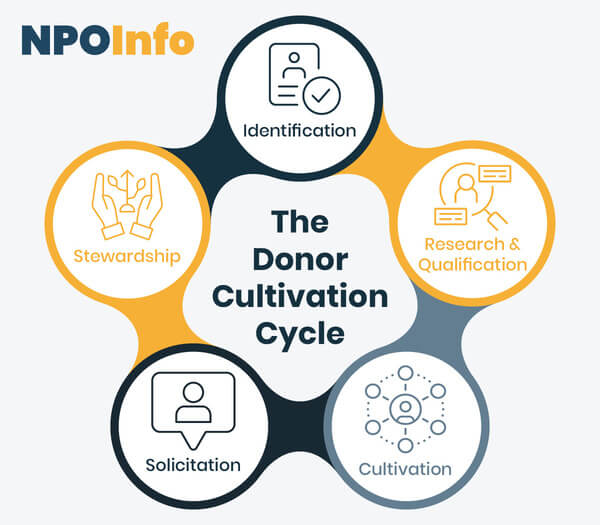
Step 1) Identification
The first step in the donor cultivation cycle is to identify potential donors. This stage requires finding people who have the capacity and interest to support your cause.
To create a list of prospects, consider everyone in your network who might support your mission. They might support your work via volunteering or some other method. You can also assess board members’ and donors’ networks to generate this list.
Step 2) Research and Qualification
Once potential donors are identified, your organization qualifies them by assessing their giving capacity, philanthropic interests, and likelihood of supporting the organization. This step in the donor cultivation cycle helps you prioritize which donors to engage with more deeply.
Heavily dependent on thorough prospect research, this stage allows you to determine whether the prospects you’ve identified will be high-capacity donors for your mission. Donorly’s prospect research guide explains you should look into two types of data during this stage:
- Capacity (wealth) markers: These data points indicate a donor’s financial position and help predict whether they’d be a high-capacity donor for your nonprofit. Examples of capacity markers include real estate ownership, stock holdings, and business affiliations.
- Affinity (warmth) markers: These data points show whether a donor might be interested in supporting your mission based on their experiences or values. Examples of affinity markers include political involvement, and demographics.
If you find that you’re missing any of this information, that’s a strong indication that you should conduct a data append. You’ll be able to fill in information that’s inaccurate or missing from your CRM, whether you need to append demographic details, wealth indicators, or contact information. Doing so will help you paint a complete picture for each prospect.
Step 3) Cultivation
Here comes the fun part: getting to know your prospects! This step in the donor cultivation cycle is where you begin forming a relationship with each potential donor. This might involve activities like:
- Sending personalized communications that appeal to their interests
- Inviting them to your nonprofit’s events or tours
- Promote volunteer opportunities
The goal of this stage is to educate the prospective donor about your nonprofit’s mission, programs, and impact. To cultivate donors, you’ll need to use this stage to build trust and rapport, positioning your organization as trustworthy and impactful.
Step 4) Solicitation
Once you’ve sufficiently cultivated a relationship with a prospect, it’s time to make a direct ask for a gift.
This may involve making a face-to-face request, sending a fundraising letter or email, or making an online appeal. It all depends on the individual’s communication preferences.
In any case, the solicitation should be personalized and aligned with the donor’s interests and giving capacity. Take a look at the philanthropic and wealth indicators you found during the research stage. Then, tailor your ask to fit their budget and appeal to what draws them toward your organization.
Step 5) Stewardship
You’ve successfully acquired a donation. Wonderful! The work isn’t done yet. After all, it is a donor cultivation cycle.
After receiving a gift, your nonprofit should engage in stewardship activities, including:
- Thanking the donor with a personalized thank-you email, handwritten letter, or a gift for impactful donations
- Acknowledging their gift’s impact on your beneficiaries
- Reporting back on how the funds were used to further your mission
One of the biggest considerations in your cycle is how you’ll sufficiently steward donors since this directly impacts retention. The key is timely, consistent, and genuine communication. After all, they clearly already believe in your mission.
Even after you steward donors, you’ll need to enter them back into the donor cultivation cycle, so you can upgrade them. Over time, you’ll strengthen your financial stability and build a reliable base of donors.
5 Donor Cultivation Strategies
While understanding the general donor cultivation cycle is certainly helpful, you need some concrete strategies that tailor your plan to your audience. Let’s walk through five of our favorite ideas.
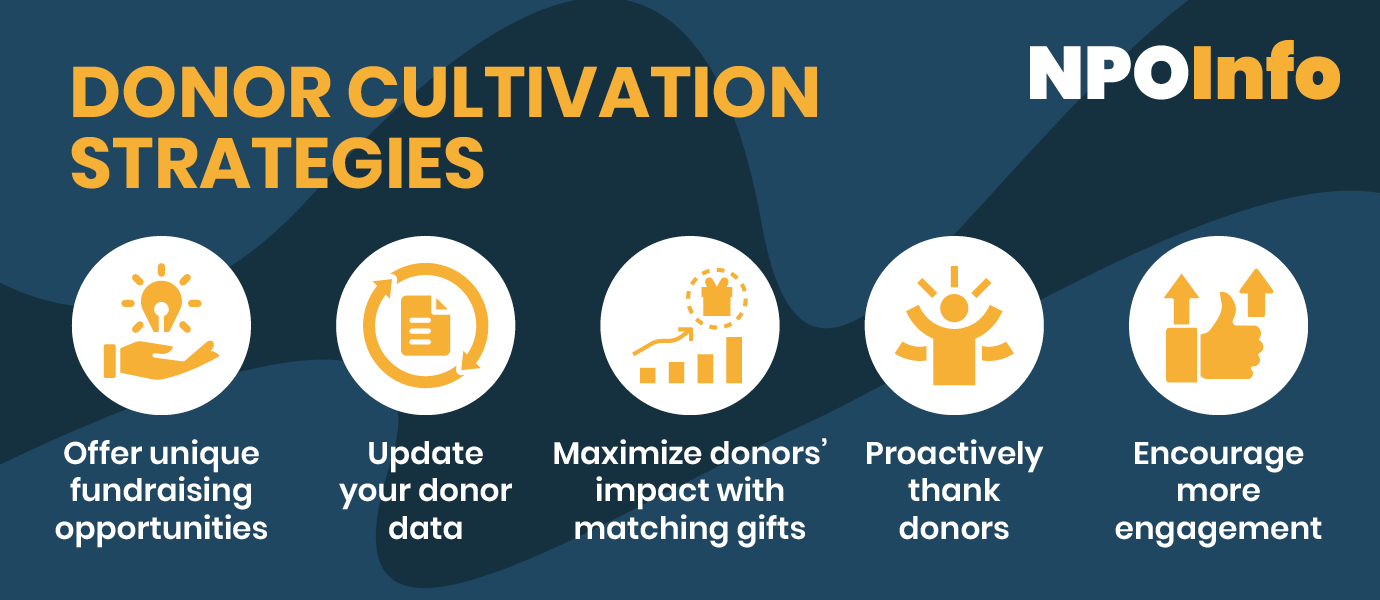
• Offer Unique Fundraising Opportunities.
One of the keys to inspiring donations is to offer unique fundraising opportunities. Our favorite option is donation eCards. Everyone loves receiving a greeting card, even more so when the proceeds go to a good cause!
You can create eCards branded to your mission that donors can send to their loved ones, either letting them know they gave in their name or challenging them to donate too.
Alternatively, create cards for special occasions that anyone can buy. That way, you can help supporters celebrate birthdays, say thanks to their loved ones, or send well wishes with holiday donation cards.
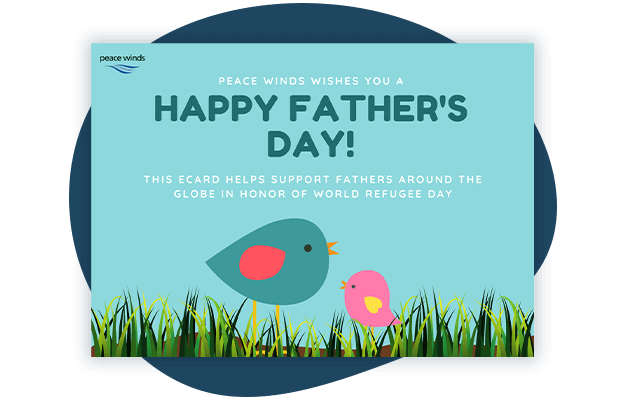
Then, you have a few ways to sell them to donors. Fundraising Letters’ charity eCards guide explains you can offer them in three ways:
- Use eCards as integrated donation forms. Add eCards directly to your site’s donation process. With this approach, a donor selects their preferred eCard, chooses a donation amount, adds the recipient’s contact information, and supplies their payment details.
- Sell eCards as fundraising products. If you have an online fundraising store, add your eCards and sell them for fixed rates. Donors can browse your collection, personalize the eCards, and send them to loved ones.
- Add eCards to your donation confirmation page. Embed your eCards into your giving confirmation page. While you can promote the reward before someone donates, it can be a fun surprise if a donor doesn’t know they can send an eCard until it pops up on the confirmation page.
The key to this donor cultivation strategy is to leverage a strong eCard creation platform. We recommend eCardWidget for its user-friendly design tools and fundraising features. The platform makes it incredibly easy to sell digital greeting cards for your cause. Plus, it’s a fantastic way to incentivize donors to give (and keep giving)!

• Ensure You Have Updated Donor Data.
Your donor data is crucial to the donor cultivation cycle. Beyond your initial research, you’ll need to maintain sufficient data to ensure your communications are delivered and based on accurate information.
Common donor data we recommend consistently monitoring include:
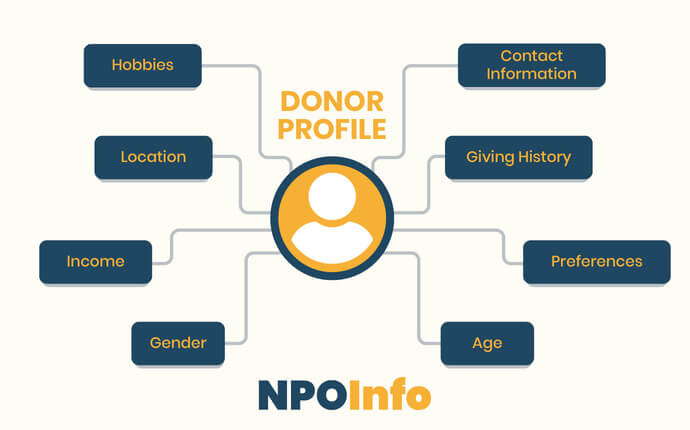
- Contact information: Consistently update postal addresses, phone numbers, and email addresses. Accurate contact details are essential for effective communication and engagement. Otherwise, your messages will go undelivered.
- Giving history: Track donors’ giving history, including the amount, frequency, and date of their donations. You can then use this data to identify giving patterns and generate targeted fundraising appeals.
- Demographic information: Collect demographic information about donors, such as age, gender, and income. Knowing this information will allow you to craft appeals tailored to their budgets and programmatic interests.
- Donor preferences: Your nonprofit should track donors’ interests, values, and philanthropic preferences. Knowing this information can help tailor engagement efforts to each donor’s individual needs and build a deeper relationship.
Note that data appends can help you acquire any missing or outdated information in your CRM. Essentially, this process involves cross-checking the information you have with an external comprehensive database to ensure you have the right information.

• Maximize Impact With Matching Gifts.
One simple yet highly effective way to cultivate donors is with corporate matching gifts. As a form of corporate philanthropy, matching gifts multiply the gifts your donors give. If their employer offers one of these programs, their donation to your nonprofit might be eligible to be matched, effectively doubling their contribution.
Double the Donation’s donation matching guide explains that there are a few key times to promote corporate giving during the donor cultivation cycle:
- During the donation process: Donating is when engagement is at its pique. Share information about donation matching by adding a snippet about it on your donation form and adding an employer research tool to your confirmation page.
- Throughout your website: Prospective and current donors alike will turn to your website for updated information about your cause. No matter where they are in the donor cultivation cycle, encourage them to check their eligibility. You can also design a page devoted to explaining matching gifts.
- Across communications: Donor cultivation requires open communication. From your social media posts to your monthly newsletter, mention donation matching whenever you can!
Regardless of timing, promoting matching gifts is great for inspiring initial donations and encouraging donors to take their existing donations further.
Make sure you have accurate employer information for your donors, so you can follow up with match-eligible supporters and cultivate lasting relationships. Learn more about this process with our guide to employer appends for nonprofits.
• Proactively Thank Your Donors.
Showing appreciation is crucial for inspiring donors to stick around. When you treat your existing donors with respect, the word will get around to prospective ones as well.
Make supporters feel valued by consistently recognizing their generosity. Here are a few donor recognition ideas that work for any organization:
- Thank-you eCards. While great for fundraising, eCards are also a fantastic recognition strategy. Sending a personalized eCard can help communicate that individual donors are valued and appreciated. Create one or two thank-you card designs you can send whenever someone gives. Then, personalize the message sent with each eCard with the donor’s name, giving amount, and a message from your team.
- Donor gifts. From branded merchandise to full-out donor appreciation events, gifts can help cultivate relationships with existing donors. Re:Charity’s guide to donor gifts recommends picking gifts based on donation tiers. After all, donors entrust you because they respect your ability to spend fundraising revenue properly. For example, a personalized eCard is great for someone who gives $25, while a gift basket is more appropriate for someone who gives $1,000.
- Impact reports. Creating an impact report that highlights the organization’s accomplishments and the impact of donors’ support can be a powerful way to show appreciation and cultivate donors. Within your report, include statistics, stories, and testimonials that demonstrate the organization’s success thanks to donors.
Beyond post-donation, reaching out during other times of the year lets donors know you’re thinking about them. Connect with them during the holidays and other special occasions to reiterate your gratitude for their continued support. Remember, timely and consistent communication is key for effective donor cultivation.
• Encourage Other Forms of Engagement.
When it comes to donor cultivation, other forms of engagement outside of donating can be just as meaningful. A couple of ways that can help you build meaningful donor relationships include:
- Volunteerism: Sharing volunteer opportunities can be an effective way to grow support. Volunteerism allows donors to engage with the organization on the ground level and provides opportunities for them to use their skills and expertise to support the cause.
- Events: Build a sense of community around your cause by hosting regular events and inviting committed supporters. Hosting events such as tours, volunteer events, or donor appreciation events can help donors feel more connected to your work. Events provide opportunities for donors to meet staff, learn more about your work, and see the impact of their support firsthand.
Overall, getting donors involved in other areas of your organization can help them understand why financial support is so crucial. Plus, they’ll see that your nonprofit views them as more than a funding opportunity.
Aside from asking supporters to get directly involved with your nonprofit in new ways, you can also increase their engagement by reaching your donors and target audiences in more places. This involves expanding your nonprofit’s network of partner organizations and corporate sponsors.
Consider the direct touchpoints that your supporters have with your nonprofit. Right now, they might include hearing about you from friends and family, making a first donation, attending an event, receiving ongoing updates and appeals, giving recurring donations, volunteering, or having one-on-one chats with your development team. But if you can find ways to grow deeper roots in your community and reach supporters outside of these direct interactions, you can become a more meaningful, recurring part of their lives.
For example, consider these indirect touchpoints you might foster through expanding your nonprofit’s network:
- Establishing workplace giving programs with local businesses
- Securing event and campaign sponsorships from businesses
- Partnering with other organizations in the community to co-host programs and events
- Lending volunteer power to public institutions like libraries and parks with special events
- Weighing in on public issues and state and local policy developments that relate to your mission
- Joining debates and roundtables hosted by other groups in the community
- Offering free educational programming in partnership with peer organizations and community groups
Each of these strategies can grow your audience, strengthen your partnerships, and ultimately make your nonprofit a more central part of your supporters’ lives. When your organization is recognizable as an active player in the community, engaged with businesses, community groups, and governments, you can foster longer-lasting and more meaningful relationships with donors.
Corporate giving programs are among the easiest ways to get started expanding your network and building more touchpoints with donors. That’s because they’re mutually beneficial for both your nonprofit and businesses, which receive public recognition and increased employee engagement as a result of giving back to the community. It’s a win-win!
Pro tip: Kick off your relationship-building efforts by digging into your data! If you have records of donors’ employers (or can secure this data through an append service), see if any businesses crop up repeatedly. Research their corporate giving programs, promote relevant opportunities like matching gifts to those donors, and then reach out to the business to express your thanks and discuss additional partnership opportunities.
Final Thoughts on Donor Cultivation
Effective donor cultivation looks different for every organization. Beyond understanding the fundamentals of the cycle, your nonprofit will thrive by experimenting with different strategies like thank-you eCards and data appending.
Remember, the cycle is an ongoing process. It never truly ends. Rather, you need to re-enter donors into the cycle every time they give, so you can maintain those relationships and upgrade their support.
As you refine your donor cultivation strategies, check out these additional resources:


